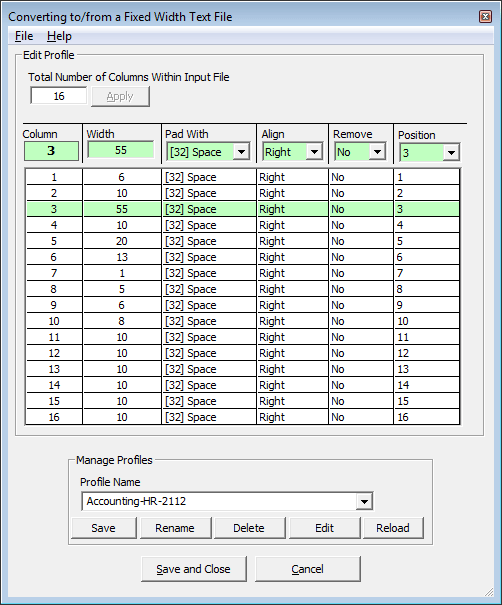NOTE: After installation, you can find simple batch files (e.g.
CSVtoTXT.bat) for quick and easy usage by
going to Start\All Programs\Convert XLS\Example Batch Files. These will work
immediately if the installation was done in the default folder.
if you have any questions or need additional examples. We will get you up and running fast!
For the full, accurate, and most recent
information see the 'Convert XLS' command line documentation.
If you have trouble running these examples see
Helpful Hints For Creating a Command Line.
There are two approaches to using the command line:
- Specify one or more conversion tasks in a 'Conversion Job'
- Specify a single conversion task in detail
A 'Conversion Job' is easily built using the 'Convert XLS' graphical user interface.
All the details of the job are saved in a single conversion job file (e.g. 'c:\myjobs\Do-Multi-Step-Conversion.SII).
Specifying a conversion job file with the command line is very easy by using the /J switch. You can have hundreds or thousands of tasks
specified in the conversion job file, all of which will get executed in one fell
swoop. For example:
ConvertXLS.EXE /J"D:\Job Files\Convert
CSV to Text.SII"
Specifying a single conversion task requires a bit more effort, but does not require
the prior creation of a 'Conversion Job' file. Everything that follows below will be about
creating a 'conversion task' to convert from
CSV to TXT by command line.
The first example shows how to convert the most popular form of a
CSV file, a comma delimited file, to a Fixed Width Text file
using the ‘Convert XLS’ conversion
method. If you have a bar "|" (ASCII
124), or a tab (ASCII 9) delimited CSV file simply swap out the
44 (ASCII value for the comma) with the appropriate ASCII
numeric value. Also, this example illustrates one of three
viable methods to convert from a CSV to a fixed width text file.
In example 1 we show how to specify every columns width.
Alternatively you can have it auto size the column width to
retain all the data by simply changing the 4th
item in the /N
switch from 2 to 0. In this case you do not need to specify the
column widths. Example 2 will demonstrate this. The 3rd
example shows how to use the ‘MS Excel’ conversion method. Note
that it is only with the ‘Convert XLS’ conversion method that
you can specify each column individually.
Each
switch shown in blue is described in detail below the examples
given. It is highly recommended you review each switches
description before implementing the example, thereby giving you
the full power of ‘Convert XLS’.
Example 1: CSV File to a Fixed Width Text File (Specify Columns)
First specify your fixed width text file format using the
Using the Fixed Width Text Profile Editor. You give a
profile a name, in this case lets call it
Profile142. To convert a
single comma delimited CSV file (recall that the comma character
has an ASCII numeric value of 44), "C:\in\input.CSV" to an fixed
width text file the following syntax would be used:
ConvertXLS.EXE /S"C:\in\input.CSV"
/T "C:\out\out.txt" /C21
/F6 /M2
/N"^^44^2^Profile142"
/V
To convert a whole folder (and subfolders)
of comma delimited CSV files, C:\in\*.CSV to fixed width text
files located in the C:\out\ folder, the following syntax would
be used:
ConvertXLS.EXE /S"C:\in\*.CSV"
/T
"C:\out\*.txt" /C21
/F6
/M2
/N"^^44^2^Profile142"
/R
/V
The /G switch can
be used to tell ‘Convert XLS’ to simply place each output file
in the same folder as each input file. Therefore the command
line above is equivalent to the command line below:
ConvertXLS.EXE /S"C:\in\*.CSV"
/G
/C21
/F6
/M2
/N"^^44^2^Profile142"
/R
/V
You may simply want
to convert a whole folder and its subfolders and place the
output into a separate folder/drive. In which case use this
syntax:
ConvertXLS.EXE /S"C:\in\*.CSV"
/T
"C:\Out\*.txt" /C21
/F6
/M2
/N"^^44^2^Profile142"
/R
/V
Example 2: CSV File to a Fixed Width Text File (Autosize Columns)
This is identical to the first example of
Example 1, however this time we don’t specify each column width,
rather, we allow ‘Convert XLS’ to automatically size the columns
to fit all the data. Notice the only change is in the /N switch.
ConvertXLS.EXE /S"C:\in\input.CSV"
/T
"C:\out\out.txt" /C21
/F6
/M2
/N"^^44^0"
/V
Of course the
example immediately above can be adapted to do whole folders and
subfolders similar to what we did in Example 1.
Example 3: CSV File to a Fixed Width Text File (Using ‘MS Excel’ Conversion Method)
In this case we use MS Excel to convert from a CSV file to a Fixed Width Text file.
Notice that when using the ‘MS
Excel’ conversion method, we can’t specify each column width and
this will be a slower conversion.
ConvertXLS.EXE /S"C:\in\input.CSV"
/T
"C:\out\out.txt" /C21
/F6
/M1
/N"^^44"
/V
Command line switches used to convert
CSV to text
- The /S and /T
switches above specify Source (input) and Target (output) path respectively
and are both required when converting a single file. It is always
a good idea to use double quotes around the path especially if there
are space characters within the path.
- The /C21
switch specifies that the target (output) file to be a fixed width
text file whereas the /F6 switch specifies the input
file is a CSV file. See
Excel Conversion File Type Constants for all possible values for /C and /F.
- The /M2
switch tells it to use the 'Convert XLS' conversion method which is
exceptionally fast and allows for
the specification of each columns width. /M1 switch is used to specify the
'MS Excel' conversion method which is a bit slower and requires
MS Excel.
- The /R switch tells it to search the input folder
and its sub-folders for files to convert.
- /G
switch can be used to tell 'Convert XLS' to place each output file
in the same folder as each input file.
- /N"{Sheet^Range^DelimChar^FixedWidth^Profile}" Is used when
converting to/from an Excel, CSV or fixed width text file. It specifies
which Sheets to convert, what Range to convert and what delimitation/separation
character to use, and the method to import export to a fixed width
text file. The syntax for this parameter is critical, the items are
separated by a caret character "^". If you do not include
Sheet, Range or DelimChar by leaving them blank they will default
to all sheets, all used ranges and the comma delimitation character.
Be certain to include the double quotation character around this parameter.
Sheet:
Use "*" or "" for all sheets. You can use names of
sheets, or the numeric index. If using numeric indices, you can specify
ranges of sheets (i.e. "1,4,10-20" and "4-10,9" etc.).
Range:
Not used in these examples. You could optionally specify a range; say
if you only wanted to convert a portion of the input file. Use the
same syntax as an Excel range (e.g. A1:B10, B:B).
DelimChar:
is for specifying the ASCII
value of the delimitation character used in a CSV
file. 44 for comma, 124 for Bar "|", 9 for the tab etc.
FixedWidth:
'Convert XLS' Conversion Method only (/M2). Here you can specify how to
import/export a fixed width text file. The following numeric values are
valid:
0 = Auto
size column widths to fit all data (Default)
1 = Use same
widths as specified in the Excel file
2 = Use widths
specified by the Profile. Widths
can be specified in the user interfaces
Fixed Width Text Profile Editor.
Profile
= If you are specifying a fixed width text profile to use do it
with this parameter. Use the Fixed Width Text Profile Editor to generate a profile.
The full path to the txt file could be used. As an example if you want to specify to convert
sheets called 'Apples' and 'Oranges', and use the range "A2:B20"
and a fixed width text file profile named MyFixedWidth
you would do so like this:
/N"Apples,Oranges^A2:B20^^2^MyFixedWidth"
- The /V (for Verbose) switch is used to give instant
feedback by having the program report the status of the conversion
with a message box. You can remove this once you have perfected your
command line specification. You can also (or instead of /V) create a Log file that will contain the
results of the conversion by using the /L
switch.
Note:
It is highly encouraged that you use the Verbose (/V) switch initially
to see what the status of your conversion is and to help you perfect your
command line. When in verbose mode the program will tell you what went
wrong or right with your command line using message boxes.



